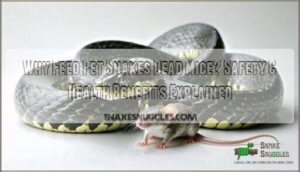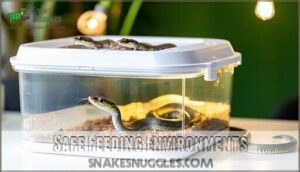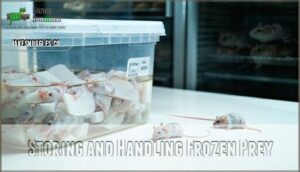This site is supported by our readers. We may earn a commission, at no cost to you, if you purchase through links.

Dead mice provide the same complete nutrition your snake needs, with balanced vitamins and minerals that sustain healthy growth. Veterinarians and reptile experts recommend this method because it reduces stress for both your snake and the prey animal.
Plus, you can store frozen mice for months and feed on your schedule. The shift techniques and storage tips that follow will help you master this feeding approach.
Table Of Contents
- Key Takeaways
- Why Feed Pet Snakes Dead Mice?
- Are Dead Mice More Humane for Feeding?
- What Are The Health Benefits for Snakes?
- How to Transition Snakes to Pre-Killed Prey
- What Are The Best Practices for Feeding?
- Is Feeding Live Prey Legal or Advisable?
- Frequently Asked Questions (FAQs)
- How often should I feed my pet snake?
- What should I do if my snake refuses to eat?
- Can I give my snake vitamins or supplements?
- What type of water should I provide for my snake?
- How do I prevent my snake from associating my hand with food?
- How much do frozen mice cost monthly?
- Can snakes get parasites from dead mice?
- Do all snake species accept pre-killed prey?
- How long can frozen mice be stored?
- What size prey should I feed my snake?
- Conclusion
Key Takeaways
- You’ll protect your snake from injuries – Dead mice eliminate bite wounds, scratches, and infections that live rodents can cause during feeding, making it the safer choice for your pet’s health.
- You’ll get the same complete nutrition with less hassle – Pre-killed frozen mice provide identical vitamins, minerals, and protein as live prey while offering convenient storage for months and scheduled feeding flexibility.
- You’re following expert recommendations – Veterinarians and reptile specialists consistently advise pre-killed prey over live feeding due to safety benefits and reduced stress for both snake and owner.
- You’re making a more humane choice – Dead mice reduce prey animal suffering while meeting your snake’s nutritional needs, aligning with modern animal welfare guidelines and ethical feeding practices.
Why Feed Pet Snakes Dead Mice?
When you’re choosing between live and dead mice for your snake, dead prey offers significant safety advantages that protect your pet from injury. Pre-killed frozen mice eliminate the risk of bites and scratches while providing the same nutritional value, making them the preferred choice among reptile veterinarians and experienced keepers.
Dead mice protect your snake from bites and scratches while delivering identical nutrition to live prey
Safety for The Snake
Dead mice are your safest bet when feeding pet snakes. Live rodents pack some serious risks that could leave your snake injured and you with an expensive vet bill.
- Bite wounds: Those little teeth can do real damage to your snake’s face or body
- Scratch injuries: Sharp claws tear skin and open the door for nasty bacterial infections
- Venomous safety: Even harmless pet snakes can get hurt badly by desperate, frightened prey
- Prey handling safety: Dead mice can’t fight back or panic
- Snake stress reduction: Your snake gets dinner without the drama of a wrestling match
Convenience for Owners
Pre-killed prey makes snake care way easier. You can stock up on frozen options that keep for months in your freezer.
No more scrambling for food means you feed on your own timeline. Your schedule, your rules – that’s the kind of flexibility every snake owner wants.
Frozen rodents beat the hassle of live feeding every time. Simple storage, simple feeding, simple life.
Recommended by Experts
Most snake experts will tell you straight up: stick with prekilled prey. It’s not just a suggestion – veterinary professionals at major universities actively recommend pre-killed diets for pet snakes. Here’s why they’re so adamant about it:
- Veterinary guidance emphasizes safety over natural hunting behavior
- Animal welfare organizations advocate against live feeding practices
- Reptile care specialists recommend frozen-thawed prey as standard
- Best practices guidelines prioritize snake health and injury prevention
- Ethical considerations favor reducing unnecessary prey animal suffering
Are Dead Mice More Humane for Feeding?
When you choose dead mice for your snake, you’re making a decision that reduces suffering for the prey animal. Veterinary and animal welfare organizations recommend pre-killed prey because it eliminates the stress and pain that live rodents experience during capture and consumption.
Reducing Prey Suffering
Prekilled prey drastically cuts down on animal suffering. Frozen rodents spare live mice from the terror and pain of being hunted and killed, creating a much more humane feeding process for your snake.
| Live Prey Impact | Prekilled Alternative |
|---|---|
| Stress and fear during hunt | Peaceful, instantaneous death |
| Pain from snake constriction | No suffering during feeding |
| Fight-or-flight response | Calm feeding environment |
| Extended suffering period | Immediate, humane process |
Using prekilled prey is simply more humane while still giving your snake proper nutrition.
Animal Welfare Guidelines
Major veterinary and animal welfare organizations actively discourage live feeding unless absolutely necessary for your snake’s health. These guidelines stem from ethical concerns about unnecessary prey suffering and legal restrictions in various regions. You’ll find that animal protection agencies recommend pre-killed prey as the standard for reptile care and nutrition.
Here are 5 key animal welfare guidelines for ethical feeding:
- Use CO₂-euthanized frozen prey – Humane treatment standards require prey animals be killed quickly and painlessly
- Follow veterinary recommendations – Exotic vets strongly advise against live feeding for snake rights and safety
- Check local regulations – Some areas legally restrict live feeding when alternatives exist
- Prioritize prey welfare – Choose methods that minimize animal suffering during the feeding process
- Endorse ethical feeding practices – Professional reptile organizations advocate for pre-killed prey as best practice
Feeding pet snakes requires understanding of pre killed diets.
Ethical Feeding Practices
You’re making an ethical choice when you feed dead mice to your snake. Animal welfare experts agree that pre-killed prey reduces unnecessary suffering compared to live feeding.
Snake welfare improves while respecting prey ethics and animal rights. This approach aligns with modern reptile care standards and feeding morality guidelines that prioritize humane treatment for all animals involved.
What Are The Health Benefits for Snakes?
Pre-killed mice give your snake complete nutrition without the risk of bites from live prey fighting back. Your pet stays safer and less stressed since there’s no dangerous hunting involved—no chance of scratches, infections, or other injuries from defensive rodents.
Plus, your snake won’t have to deal with the stress and potential danger that comes with live hunting, where aggressive prey can cause real harm.
Complete and Balanced Nutrition
Beyond ethical concerns, dead mice deliver excellent reptile nutrition. Your pet snakes receive complete dietary variety through whole prey items that maintain food quality during freezing. Here are five key nutritional benefits:
- Complete protein profiles for ideal digestive health
- Essential vitamins and minerals preserved through proper freezing
- Balanced fat content supporting snake care and feeding routines
- Natural calcium-phosphorus ratios eliminating nutritional supplements needs
- Consistent nutrient density across different prey sizes
This makes snake diets straightforward and reliable.
Lower Risk of Injury or Infection
Prekilled diets eliminate three major hazards in reptile feeding. Live rodents pose real dangers – they can bite and scratch your snake during feeding, potentially transmitting diseases through these wounds.
Frozen rodents offer much better disease control since proper handling eliminates harmful bacteria and parasites. Your feeding routine becomes cleaner and safer, protecting both your snake and maintaining better hygiene standards.
Stress Reduction for Snakes
Switching to prekilled prey can make a world of difference for your snake’s well-being. When you offer frozen-thawed meals instead of live prey, you’re removing the whole predator-prey drama from feeding time. Your snake still gets the same nutritional benefits without the stress of an actual hunt.
This calmer feeding approach does wonders for reducing anxiety in captive reptiles. Without the pressure of chasing down dinner, snakes can focus on what matters most – staying healthy and maintaining their natural behaviors in a controlled environment.
The end result? Better welfare for your pet and more predictable feeding routines for you.
How to Transition Snakes to Pre-Killed Prey
If your snake currently eats live prey, you can successfully shift them to pre-killed rodents using proven techniques that maintain their feeding response.
The process requires patience and specific methods like warming frozen prey to body temperature and using movement to trigger their natural hunting instincts.
Warming and Scenting Techniques
Your snake won’t eat prekilled prey? Heat Sources and Temperature Control make frozen rodents irresistible. Warm prey to body temperature using warm water or heating pads.
Scent Enhancement works wonders—rub the rodent with bedding from live prey.
These Feeding Stimulation techniques trigger natural hunting instincts, making prey presentation successful for even picky pet snakes.
Using Feeding Forceps
Professional feeding forceps provide important Snake Safety when presenting frozen prey. Use feeding tongs to keep your hands safe and maintain snake feeding safety, allowing proper Prey Presentation for pet snakes.
Essential Forceps Handling techniques:
- Choose 10-12 inch stainless steel feeding tools for distance
- Give that prey item a subtle wiggle right within your snake’s line of sight
- Maintain steady grip during reptile nutrition sessions
- Position prey at head level for natural striking angles
- Never rush – let your snake assess the frozen prey offering
Encouraging Reluctant Eaters
Patience becomes your greatest ally when dealing with stubborn snakes who turn their noses up at frozen prey. Try moving the thawed rodent with feeding forceps to mimic natural movement, creating an irresistible feeding environment.
Some Snake Feeding Tips include scenting frozen prey with live bedding or using prey presentation techniques that trigger Snake Appetite Stimulation through visual cues.
What Are The Best Practices for Feeding?
You’ll want to establish a consistent feeding routine that prioritizes safety and proper handling techniques for both you and your snake.
Following evidence-based practices for storage, preparation, and monitoring ensures your snake receives ideal nutrition while minimizing health risks.
Safe Feeding Environments
Creating the right environment matters when you’re feeding your snake pre-killed prey. Your reptile enclosure should remain separate from feeding areas to prevent territorial behavior and substrate ingestion.
- Use dedicated feeding containers with secure lids for snake safety
- Control temperature and lighting during feeding sessions for ideal reptile care
- Position feeding containers away from high-traffic areas to reduce stress
This approach promotes humane handling practices while maintaining proper environmental control throughout your snake feeding and nutrition routine.
Storing and Handling Frozen Prey
Proper freezer storage keeps frozen rodents fresh for months while maintaining nutritional value. Store prey in airtight containers or freezer bags to prevent freezer burn and contamination.
When thawing, use warm water baths, but never use microwaves, as they create hot spots that can burn your snake.
Practice good feeding hygiene by washing hands before and after prey handling, and maintain a frozen inventory system to track expiration dates for best reptile care.
Feeding Frequency and Monitoring
Adult snakes usually eat every one to two weeks, while growing juveniles need meals every five to seven days. Monitor your snake’s weight monthly to track healthy growth patterns.
Adjust feeding cycles based on your pet’s age, species, and body condition. Consistent feeding schedules promote proper reptile care and nutrition.
Is Feeding Live Prey Legal or Advisable?
You’ll find that live prey feeding sits in a legal gray area, with some regions restricting or discouraging the practice due to animal welfare concerns.
Most veterinary experts and reptile organizations recommend against live feeding unless your snake absolutely refuses pre-killed prey, citing both safety and ethical considerations.
Legal Restrictions and Regulations
Legal Restrictions and Regulations vary markedly across jurisdictions. In the UK, feeding live vertebrate prey to reptiles isn’t strictly illegal under the 1911 or 2006 Acts unless it causes unnecessary suffering, though Animal Welfare Laws strongly discourage it.
The Prevention of Cruelty to Animals Act provides Legislative Frameworks that allow prosecution when live prey feeding may be viewed as illegal under Animal Welfare Act provisions. Regulatory Compliance requires following Pet Ownership Rights while respecting Animal Ethics and Welfare guidelines.
Understanding animal welfare laws is vital for responsible pet ownership.
Veterinary and Welfare Recommendations
Major veterinary organizations consistently recommend pre-killed prey for pet snakes. Veterinarians recommend this practice over live prey, emphasizing Animal Welfare and Ethics. Professional Veterinary Advice endorses Humane Practices by establishing clear Welfare Standards:
- Reduced stress and injury risk for your snake
- Ethical Guidelines protecting prey animals from unnecessary suffering
- Consistent Reptile Health and Nutrition through safe Pet Care and Nutrition protocols
When Live Feeding is Necessary
Some snakes won’t accept pre-killed prey, especially wild-caught snakes with established hunting instincts. Certain snake species’ requirements make live prey exceptions necessary when reptiles refuse frozen alternatives.
Feeding emergencies may require live prey if your snake hasn’t eaten for extended periods. Specialized diets for specific species sometimes demand live feeding for proper reptile and amphibian care and nutrition.
Frequently Asked Questions (FAQs)
How often should I feed my pet snake?
Looking for feeding frequency guidance? Your snake’s size determines the schedule – juveniles need weekly meals, while adults can wait two to four weeks between feedings comfortably.
What should I do if my snake refuses to eat?
First, don’t panic—snakes sometimes skip meals naturally. Try warming pre-killed prey to body temperature, offer it in a quiet space, and maintain proper humidity and temperature in their enclosure.
Can I give my snake vitamins or supplements?
Absolutely life-changing supplements aren’t necessary for most snakes! Rodent-fed captive snakes rarely need additional vitamins since prey provides complete nutrition.
You’ll only need supplements if your vet identifies specific deficiencies or health issues requiring targeted assistance.
What type of water should I provide for my snake?
Clean water is essential for your snake’s health. Use dechlorinated tap water, spring water, or filtered water. Avoid distilled water since it lacks essential minerals your snake needs.
How do I prevent my snake from associating my hand with food?
Use feeding tongs or hooks to create distance between your hand and food. Always wash your hands after handling prey items.
Feed on a consistent schedule so your snake learns when mealtime occurs.
How much do frozen mice cost monthly?
Monthly frozen mice costs range from $5 to $15 for most snakes. You’ll usually spend about $8-12 monthly since snakes eat every 5-14 days depending on their size and species.
Can snakes get parasites from dead mice?
Yes, snakes can contract parasites from dead mice, but it’s less likely than with live prey. Frozen mice eliminate many parasites through freezing, though some hardy types might survive. You’ll lower risk greatly compared to live feeding options.
Do all snake species accept pre-killed prey?
Most snake species will accept pre-killed prey, but you’ll find some picky eaters resist the change.
Ball pythons and some wild-caught snakes can be stubborn, requiring patience and warming techniques to encourage acceptance.
How long can frozen mice be stored?
Properly stored frozen mice last six months in your freezer without losing nutritional value.
You’ll maintain their quality by keeping them at consistent temperatures below freezing and avoiding repeated thaw-refreeze cycles.
What size prey should I feed my snake?
Choose prey that’s 1-5 times your snake’s widest body part. This prey-weight ratio guarantees ideal digestion time while preventing regurgitation.
Don’t exceed 10-15% of your snake’s body weight to avoid digestive stress.
Conclusion
Switching to pre-killed prey is one of the best moves you can make for your snake’s health and safety. Once you understand the benefits – better safety, complete nutrition, and easier handling – it’s hard to argue with this approach.
You’ll keep your pet safe from potential injuries while giving them everything they need nutritionally. Pre-killed mice pack the same nutritional punch as live prey, minus the bite risk. Your snake will do great on this feeding method, and you’ll sleep better knowing you’re doing right by your pet.
- https://www.merckvetmanual.com/management-and-nutrition/nutrition-exotic-and-zoo-animals/nutrition-in-reptiles
- https://rodentpro.com/informationcenter/resources/feeding-frozen-vs-live-reptiles
- https://abdragons.com/blog/frozen-mice-and-rats-for-snake-feeding/
- https://www.reddit.com/r/snakes/comments/a5hovp/pet_snakes_being_fed_live_mice/
- https://vcahospitals.com/know-your-pet/snakes-feeding















